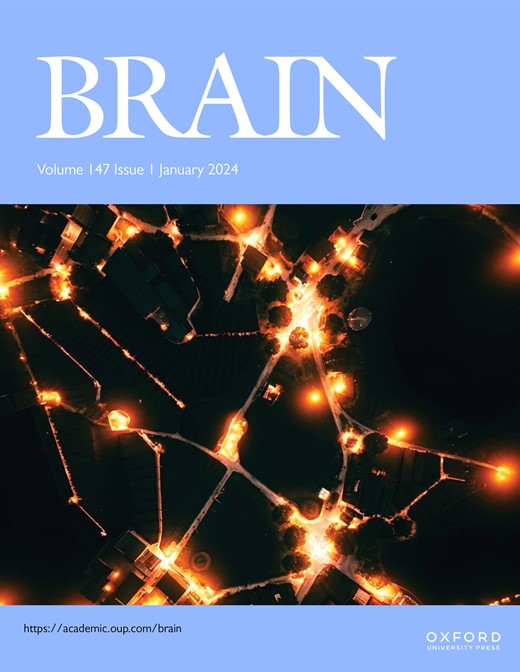SNAP25 variant I67N: synaptic phenotypes, drug response and proteome changes in human neurons
IF 10.6
1区 医学
Q1 CLINICAL NEUROLOGY
引用次数: 0
Abstract
SNAREopathies constitute a group of severe genetic neurodevelopmental disorders caused by de novo variants that disturb the synaptic release machinery. These neurodevelopmental disorders comprise highly diverse clinical phenotypes, usually including developmental delay, epilepsy, intellectual disability, and sometimes autism spectrum disorder. Despite major progress in genetic testing, current treatments are limited to symptom-directed therapies. There is an urgent need to establish human experimental systems that improve translatability and help develop personalized mechanisms-based treatment strategies. Here we generated CRISPR/Cas9-engineered human induced pluripotent stem-cell (hiPSC) lines carrying the pathogenic variant I67N in the SNAREopathy gene SNAP25. Using fast forward NGN2-dependent programming into forebrain glutamatergic neurons, we examined synaptic phenotypes using electrophysiology and immunostaining, as well as protein changes by means of proteomics. The variant did not affect passive or active electrical properties, but caused changes in synaptic transmission, including reduced evoked and spontaneous release, decreased synaptic vesicle release probability and consequential changes in short-term plasticity towards facilitation. These phenotypes were distinct from those of human neurons differentiated from hiPSCs originating from a patient carrying the V48F variant, which displayed an increase in spontaneous release. The I67N variant phenotype could be ameliorated by the clinically approved K + -channel blocker 4-aminopyridine. Proteomic analysis of hiPSC-derived neurons revealed a significant enrichment in downregulated synaptic proteins (e.g. CALB1, SCN2A, LRRC4B, PPFIA2). Our study demonstrates the use of hiPSC-based models of neurodevelopmental disorders to identify disease mechanisms and to suggest personalized treatment options directly targeting specific synaptic defects.SNAP25变异体I67N:人类神经元突触表型、药物反应和蛋白质组变化
SNAREopathies是一组严重的遗传性神经发育障碍,由新生变异引起,干扰突触释放机制。这些神经发育障碍包括高度多样化的临床表型,通常包括发育迟缓、癫痫、智力残疾,有时还包括自闭症谱系障碍。尽管基因检测取得了重大进展,但目前的治疗仅限于以症状为导向的治疗。迫切需要建立人体实验系统,以提高可翻译性,并帮助开发基于个性化机制的治疗策略。在这里,我们产生了CRISPR/ cas9工程的人诱导多能干细胞(hiPSC)系,携带SNAREopathy基因SNAP25的致病变体I67N。利用ngn2依赖性快速编程进入前脑谷氨酸能神经元,我们使用电生理学和免疫染色检测突触表型,以及通过蛋白质组学检测蛋白质变化。该变异不影响被动或主动电学性质,但引起突触传递的变化,包括诱发释放和自发释放减少,突触囊泡释放概率降低以及相应的短期易化可塑性变化。这些表型与来自携带V48F变体的患者的hiPSCs分化的人类神经元不同,后者表现出自发释放的增加。临床批准的K +通道阻滞剂4-氨基吡啶可以改善I67N变异表型。hipsc衍生神经元的蛋白质组学分析显示,下调的突触蛋白(如CALB1, SCN2A, LRRC4B, PPFIA2)显著富集。我们的研究展示了使用基于hipsc的神经发育障碍模型来识别疾病机制,并建议直接针对特定突触缺陷的个性化治疗方案。
本文章由计算机程序翻译,如有差异,请以英文原文为准。
求助全文
约1分钟内获得全文
求助全文
来源期刊

Brain
医学-临床神经学
CiteScore
20.30
自引率
4.10%
发文量
458
审稿时长
3-6 weeks
期刊介绍:
Brain, a journal focused on clinical neurology and translational neuroscience, has been publishing landmark papers since 1878. The journal aims to expand its scope by including studies that shed light on disease mechanisms and conducting innovative clinical trials for brain disorders. With a wide range of topics covered, the Editorial Board represents the international readership and diverse coverage of the journal. Accepted articles are promptly posted online, typically within a few weeks of acceptance. As of 2022, Brain holds an impressive impact factor of 14.5, according to the Journal Citation Reports.
 求助内容:
求助内容: 应助结果提醒方式:
应助结果提醒方式:


